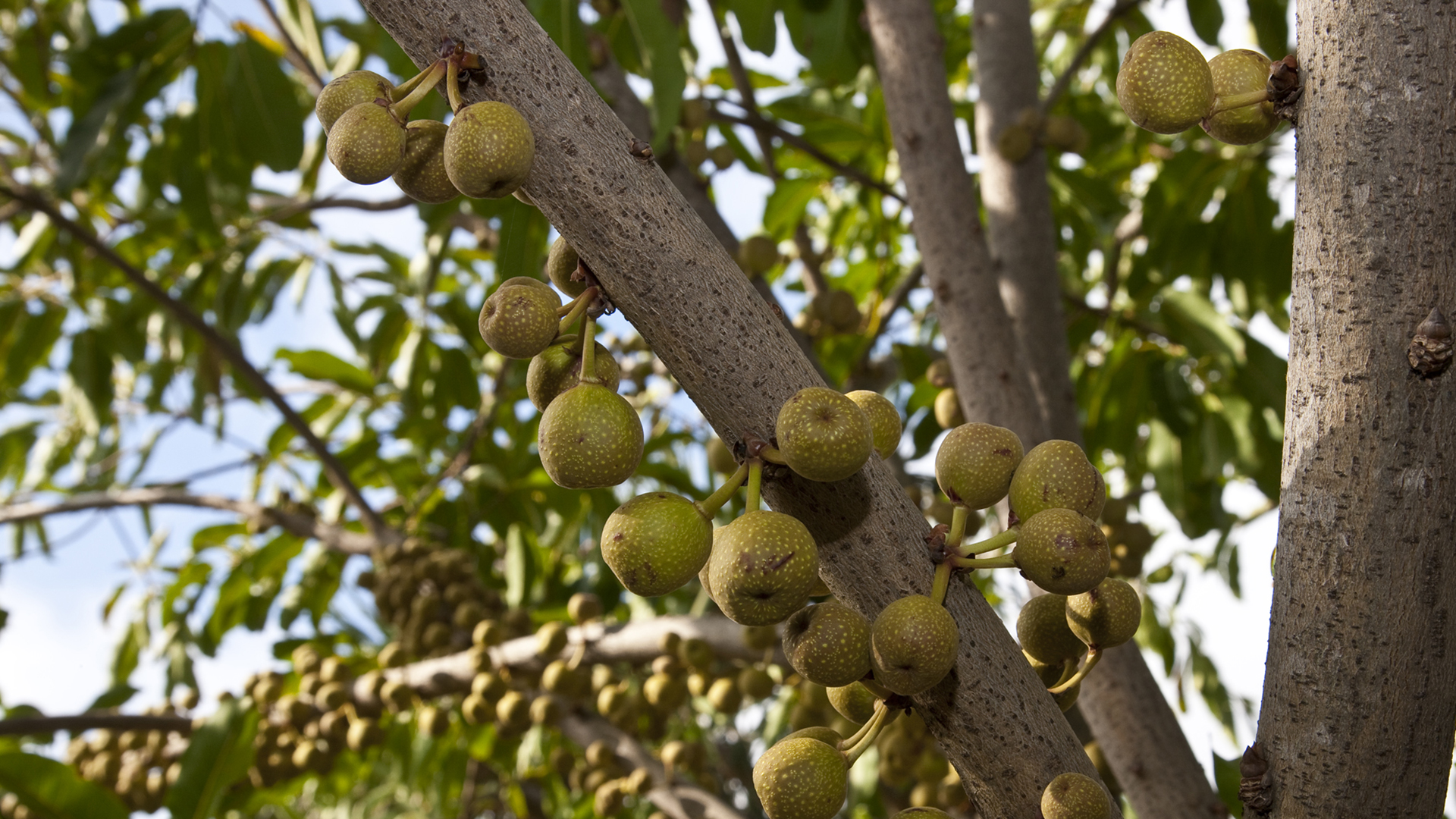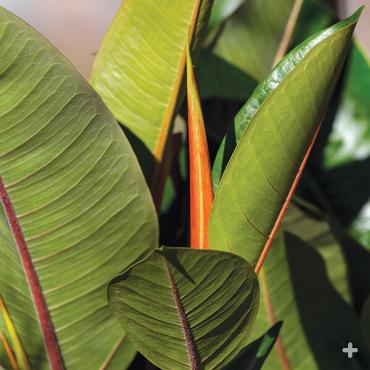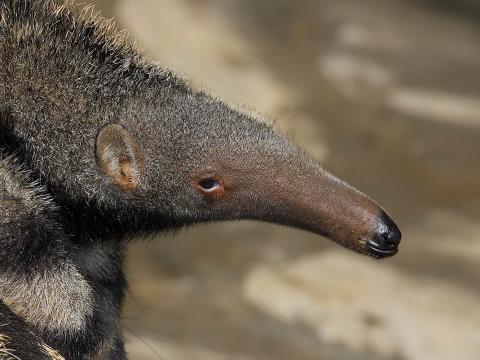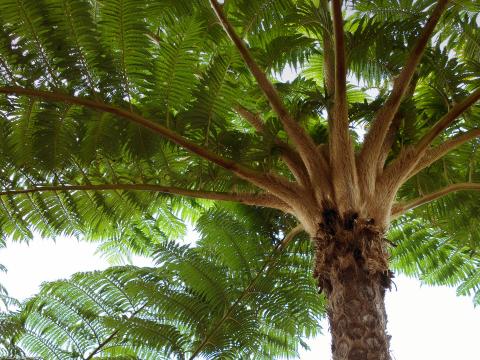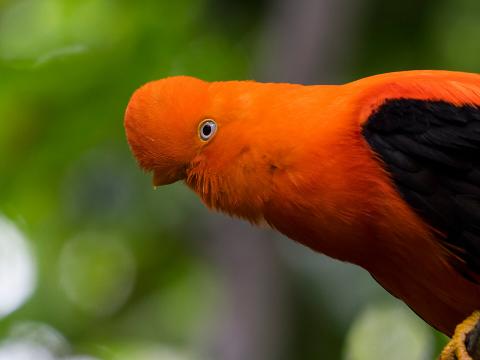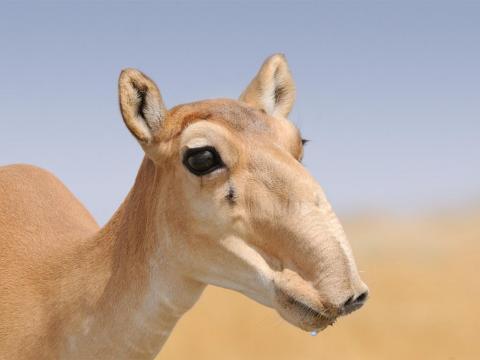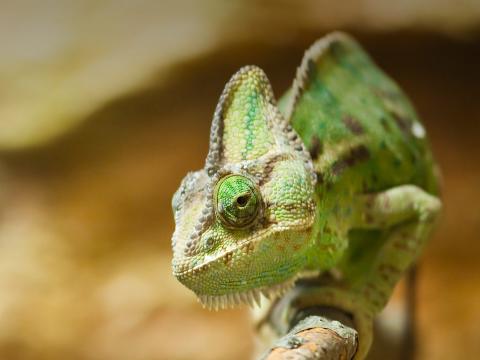Ficus (Fig)
- DIVISION: Tracheophyta (vascular plants)
- CLASS: Magnoliopsida (dicotyledons)
- ORDER: Urticales
- FAMILY: Moraceae
- GENUS: Ficus
- SPECIES: More than 800
OVERVIEW
The genus Ficus includes hundreds of species of trees, shrubs, and vines that can be found around the world, mostly in tropical and subtropical regions. Some species are lithophytes (plants that grow on rocks). Many are epiphytes (plants that grow on other plants), and in fact many ficus species start out that way. These strangler figs germinate in treetops and develop serpentine aerial roots that completely engulf their host.
Many animals, including apes, elephants, rhinos, tapirs, and giraffes, enjoy ficus browse. In fact, the Zoo's many species of ficus provide 2.5 tons (2.3 tonnes) of animal browse each month. And that's just small potatoes, compared to the natural world. Throughout the Earth's tropics, ficus provide food and habitat for a rich variety of animals. Tree-dwellers like monkeys, birds, and fruit bats enjoy the sweet fruit and disperse the seeds high in the branches of trees.
Fig Flowers
When you bite into a juicy fig, you're actually eating flowers. That "fruit" is really a hollow, fat stem tip with flowers on the inside. You might wonder how flowers enclosed in a fig get pollinated. Tiny wasps hold the key. Female wasps lay their eggs in figs, so newly hatched wasps begin their lives inside a fig. A male lives his entire life inside the same fig, and he has just one job: to mate with females before they exit. Female wasps grow wings and eventually leave their birth fig—carrying with them a bit of its pollen. Then they look for another fig. The tiny female wasp wriggles into a narrow opening at one end of her chosen fig. Safely inside, she lays her eggs—and spreads pollen from the fig she hatched in, thus helping the fig produce viable seeds. The cycle of the female wasp is complete, and she dies. Her eggs hatch, and the young wasps grow, repeating the cycle. Each wasp species pollinates its own species of ficus.
BROWSE
"Browse" refers to leafy branches that are food for certain animal. Ficus—along with eucalyptus, bamboo, and acacia—is an especially important source of browse for the animals at the San Diego Zoo. A dedicated, knowledgeable, and hard-working crew of horticulturists harvests the browse for our diverse animal collection. The Browse Department supplies the foliage that feeds many Zoo and the Safari Park species, including giraffes, koalas, giant pandas, elephants, and many primates. Our keepers enjoy the luxury of selecting browse from a barrel full of verdant, freshly cut vegetation delivered right to their area’s door, and the positive impact on our cherished animal collection is huge.
Our Collection
The San Diego Zoo maintains one of the largest ficus collections in the world. This nationally accredited collection includes more than 120 species and some of the Zoo's oldest and largest trees. You can explore our ficus plants by taking a self-guided tour through Discovery Outpost and Front Street. Look for ficus trees to play a starring role in the Zoo's newest exhibit, Conrad Prebys Africa Rocks, when it opens in summer 2017.
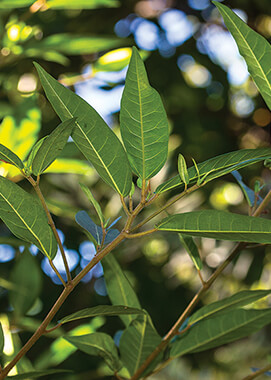
Riverine Fig
San Diego Zoo, Australian Outback
This unusual ficus is a rheophyte: a plant that grows in fast-moving water. It grows along creeks and riverbanks in New Guinea and Australia, where it survives yearly floods and strong currents.
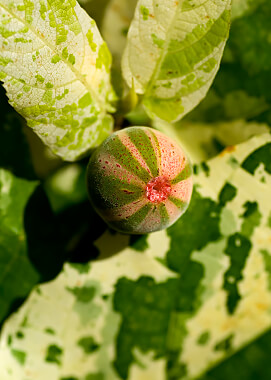
Mosaic Clown Fig
San Diego Zoo, Variegated Garden
Not long ago, variegated plants such as this one were fairly uncommon. Now, with interest and varieties at an all-time high, gardeners and plant lovers can enjoy a whole spectrum of patterns and mosaic designs.
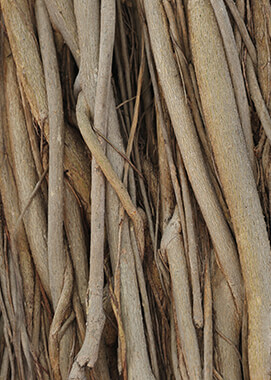
Banyan Tree
San Diego Zoo
In India and Pakistan, banyan trees grow to colossal sizes and are considered sacred. The name banyan comes from banias, the word used for Indian vendors who set up markets under these trees. Despite the tree's enormous full-grown size, it can start out as an epiphyte, growing in a treetop with air and light and rain for food, and then sends its roots down the tree's trunk to become a tree on its own.
Weeping Chinese Banyon
San Diego Zoo and Safari Park
Although this evergreen tree is known as a weeping Chinese banyan, it actually hails from India and Southeast Asia. It's a popular and easy-to-care-for houseplant, so it comes as a surprise to many people that the tree also grows well outdoors and can reach heights of up to 30 feet (9 meters).
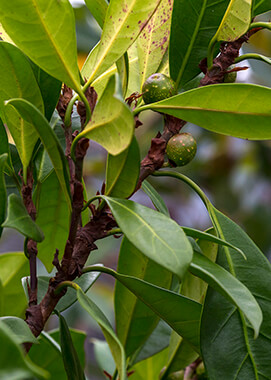
Floating Fig
San Diego Zoo, Africa Rocks
You might find this fig overhanging a stream in Central Africa. The species grows in tropical forests, as a small tree, a shrub, or a vine-like epiphyte.
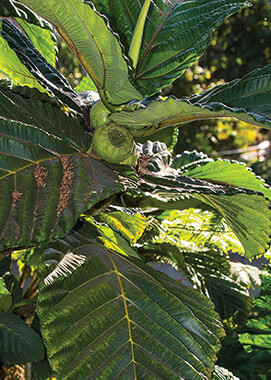
Highland Breadfruit Tree
San Diego Zoo, Bus Loading Depot
From the highlands of New Guinea, this spectacular tree produces giant leaves and softball-sized figs reminiscent of breadfruit. The tree is hard to propagate, so it is uncommon in cultivation.

Rubber Tree
San Diego Zoo, Flamingo Lagoon
Rubber trees, native to Tropical Asia, have been widely used as indoor plants for 100 years. The figs are small and insignificant, but the leaves can be 12 inches (30 centimeters) long and 5 inches (13 centimeters) wide. The bark of the rubber tree produces copious amounts of white latex sap, giving rise to its common name. Until the late 19th century, it was an important source of rubber.

Shiny Sandpaper Fig
San Diego Zoo, Australian Outback
This small tree grows near creeks and in rain forest scrublands in Vanuata, New Caledonia, and Australia. The leaves can take on many forms; sometimes they have lobed indentations on the margins.
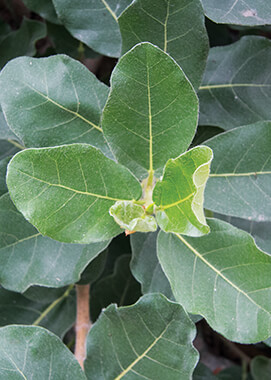
Mountain Rock Fig
San Diego Zoo, Elephant Odyssey
Found among woodlands and rocky outcrops across much of Africa, this plant is mostly absent from the tropical rain forests and arid regions within its range. The leaves from this tree have been used to treat many ailments for over 2,000 years.
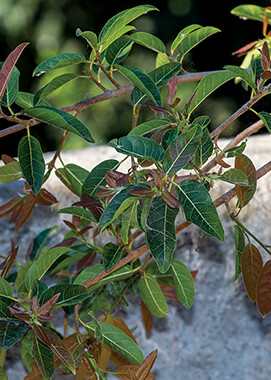
Red-leaved Fig
San Diego Zoo, Africa Rocks Kopje Exhibit
A sprawling rock fig from Africa, this tree grows on rocks or cliff faces in drier regions, becoming a forest tree in higher-rainfall areas. It goes through a brief deciduous period, followed by a flush of bright-red foliage.
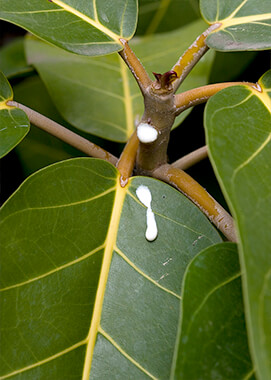
Zulu Fig
San Diego Zoo, Bus Loading Depot
One of the African strangler figs, the Zulu fig can also be cultivated as a tree. New growth is lighter than the older leaves.
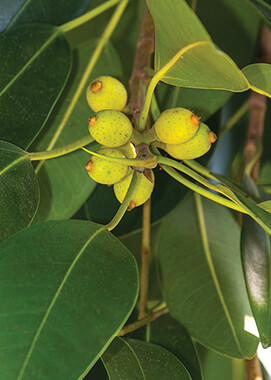
Moreton Bay Fig
San Diego Zoo, Flamingo Lagoon
Aerial roots that resemble pillars support the massive limbs of the Moreton Bay fig. With all its spreading limbs and support roots, a single tree can cover a whole acre in its native Australian habitat. One of our trees has a trunk circumference of more than 38 feet (11.5 meters)!

Malagasy Rock Fig
San Diego Zoo, Discovery Outpost
This ficus can grow as a shrub, a tree, or a small rock fig, depending on habitat. It's nearly always associated with rocks in the arid regions of Madagascar.
Indian Laurel Fig
Safari Park, Nairobi Village and African Plains field exhibits
San Diego Zoo, Africa Rocks aviary
This large fig tree at the edge of the Safari Park's Mombasa Lagoon in Nairobi Village provides shade with its thick, glossy leaves. In India and Southeast Asia, the twisting trunks and aerial roots of fig trees are thought to be the homes of spirits, and people sometimes leave offerings nearby.

Mysore Fig
San Diego Zoo, Asian Passage
Safari Park, Nairobi Village
From Mysore, India, this large tree is a rapid grower if it gets enough water and room to develop. The crisp leaves are 6 inches (15 centimeters) wide by 10 inches (25 centimeters) long and have a small "drip tip" at the end. The figs are densely covered with rust-colored fuzz that fades as a fig matures to reddish purple. This species is used as browse for Zoo primates whenever it is available; its fruits are offered to hatchlings in our Avian Propagation Center.
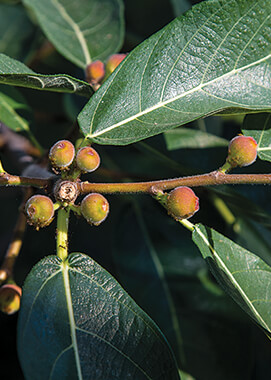
Sweet Sandpaper Fig
San Diego Zoo, Australian Outback
Found throughout the islands of southern Asia and in eastern Australia, this small, resilient plant grows in many environments and even survives occasional wildfires. Its common name comes from the sweet figs it produces and the sandpaper-like texture of its leaves.
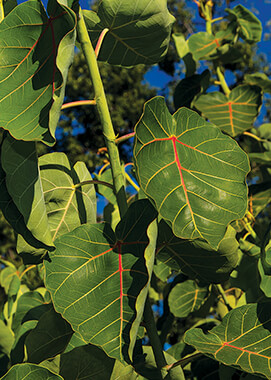
Lava Fig
San Diego Zoo, Discovery Outpost
This species from the Pacific coast of Mexico is one of the most spectacular and odd-looking fig trees on Earth. Although this species has many forms depending on its habitat, it can be found growing on boulders, with roots that look like flowing lava as they hug the rocks.

Radulina
San Diego Zoo, Sun Bear Forest
The largest tree in Sun Bear Forest, a 40-foot-tall (12-meter) radulina towers over the gibbons from the center of their enclosure, providing important shade and climbing opportunities for the primates that share the enclosure. This irreplaceable, lanky fig is only half its ultimate size.
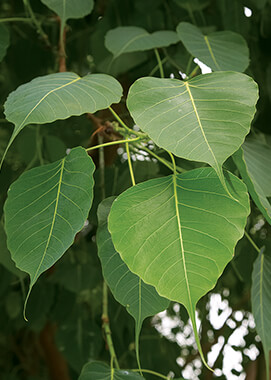
Bo Tree
San Diego Zoo, Sun Bear Forest
This fig species from India is reputed to be the one beneath which Buddha attained enlightenment. The sacred tree, with its smooth, rust-colored bark, is deciduous in San Diego. The figs are less than an inch in diameter and turn dark purple as they mature. The medium-sized leaf, 5 inches (13 centimeters) wide by 6 inches (15 centimeters) long, is heart-shaped with a wide base and a long drip tip. When available, Bo tree branches are popular browse for primates at the San Diego Zoo.
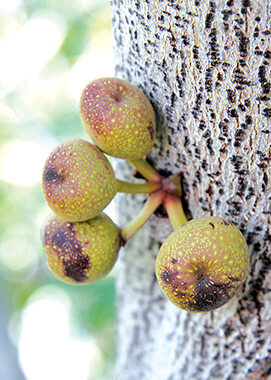
Knobby Fig
San Diego Zoo, Africa Rocks Kopje
This tree, native to eastern Africa, produces large figs that grow on the trunk and branches.

Socotran Fig
San Diego Zoo, Africa Rocks waterfall
Discovered on the islands of Socotra, off the coast of Yemen, this spectacular tree is native to many parts of the Horn or Africa as well. It requires very little care and minimal water, making it a good tree for San Diego.
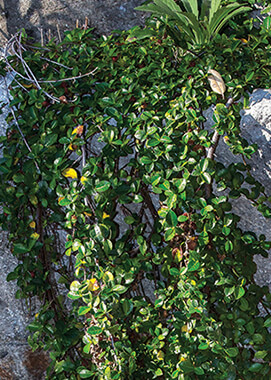
Blueberry Fig
San Diego Zoo
Not all fig trees are big. In fact, many types grow as vines, shrubs, or small plants. This sprawling, vine-like species comes from southern Taiwan, where it grows among boulders near the coastline.
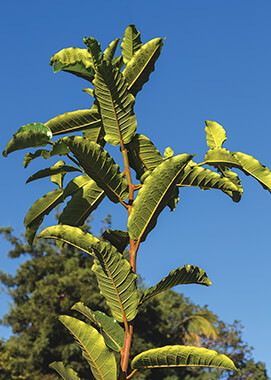
Velvet Fig
San Diego Zoo
This large tree grows in moist, upland regions from Mexico to Brazil. In its native environment, orchids, mosses, and other epiphytic plants cover its branches, creating an entire ecosystem.

Figwood
San Diego Zoo, Australian Outback
From southern Asia through northern Australia, this medium-sized tree is used by humans and animals. Metallic starlings feast on its bright-orange figs, and people have used its sap to protect against insect bites.
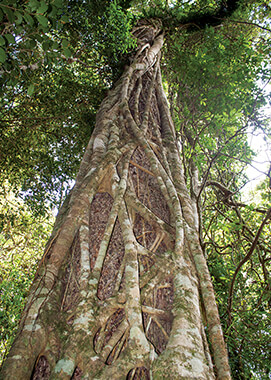
Watkins Fig
San Diego Zoo, Monkey Trails
The San Diego Zoo's largest specimen of this Australian native is our "Big Fig," a 440,000-pound (200,000-kilogram) specimen that was relocated as the centerpiece of the Monkey Trails habitat. The canopy continues to produce new growth, and the soil is full of new roots. It produces seedlings too, so we know that there must be a pollinator wasp at work. We have relocated a number of the seedlings to our nursery to plant in other areas.

